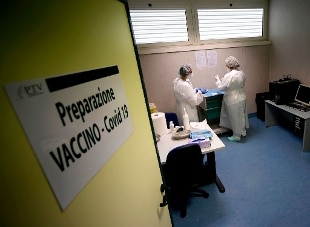Share
April 29, 2021 "Vaccine deliveries are increasing but the weekly increase is not constant and still far from 3.5 million doses, essential to reach the target of 500 thousand doses per day".
Thus the president of the Gimbe foundation, Nino Cartabellotta, commenting on the weekly monitoring data.
As of April 28 (update at 6.10) 29.5% of the doses scheduled for the first half of 2021 were delivered: 22,463,020 doses, of which 2.2 million Pfizer / BioNTech not yet entered in the database. 22% of the population received at least one dose of vaccine (13,072,472) and 9.1% completed the vaccination cycle (5,430,357), with regional differences gradually flattening out. weekly doses (+ 10.7% in the last 7 days), both at the 7-day moving average, increased from 324,081 / day (April 20) to 355,582 / day (April 27).
"Despite this increase - comments Renata Gili, Head of Research on Health Services of the Gimbe Foundation - the number of daily vaccinations does not reach the targets defined for the week 22-29 April by the Extraordinary Commissioner, documenting organizational difficulties in some regions in the timely administration of doses A clear reduction in inoculations on public holidays is also confirmed ".
As for the primary categories, if the vaccination of the over 80s is now in the pipeline, the coverage of the 70-79 range and, especially the 60-69 range, are still limited to have a significant impact on hospitalizations and intensive care. , of the over 4.4 million over 80s, 2,688,321 (60.8%) completed the vaccination course and 1,118,950 (25.3%) received only the first dose. Fragile subjects and their caregivers: 2,627 administered .502 doses, on which it is impossible to carry out further analyzes, because the total denominator and its regional distribution are not known for this category, nor the division between 1st and 2nd dose.
Age range 70-79: of the over 5.9 million, 452,245 (7.6%) completed the vaccination course and 2,794,681 (46.8%) received the first dose only. 7.3 million, 524,584 (7.1%) completed the vaccination course and 1,415,535 (19.2%) received the first dose only.
As for the risk groups, according to ECDC data, for the over 80s, while remaining far from countries that have exceeded 95% coverage, Italy has gained several positions, while for the age groups 70 -79 and 60-69 years old, our country only comes in fourth from last place.For the 70-79 age group, if 50% of the population has received at least one dose of vaccine, 19 countries have exceeded at least 60% and 8 80%; for the 60-69 range we stop at 22.5% with at least one dose, while 14 countries have already exceeded 40% and 4 50%.
"Unfortunately, the real change of pace in the vaccination of vulnerable groups - concludes Cartabellotta - only took place starting from the second half of March and the improper use of vaccines during the first quarter on the one hand makes reopening less safe, on the other hand it does not it makes us look good in Europe in comparison with other countries ".
Slow descent of cases, pressure on hospitals decreases
In the week from 21 to 27 April, compared to the previous one, there was a decrease in new cases (90,449 against 98,030) and deaths (2,279 against 2,545). This is what the Gimbe Foundation notes in its weekly monitoring.
Currently positive cases are also decreasing (448.149 against 482.715), people in home isolation (425.089 against 456.309), hospitalizations with symptoms (20.312 against 23.255) and intensive care (2.748 against 3.151).
"As expected - declares Nino Cartabellotta, president of the Gimbe Foundation - the slow and progressive descent of the new weekly cases continues, the result of the restrictions of an all-red-orange Italy of the past few weeks, which will probably continue until mid-May. Beyond that. 448 thousand cases currently positive confirm, however, that viral circulation in our country is still very high ". As always, the national data is affected by rather heterogeneous regional situations: the percentage variation of new cases increases in 3 Regions and currently positive cases are growing in 5 Regions.
"The number of beds occupied by Covid patients in the medical and intensive care departments - says Renata Gili, Head of Research on Health Services of the Gimbe Foundation - continues to drop, even if the number of hospitalized patients remains high". In detail, in the medical area, the curve peaked on 6 April with 29,337 cases and a decline of 26.6% in 21 days. Employment by Covid patients still exceeds 40% in 2 Regions. As regards intensive care, the curve peaked on 6 April (with 3,743), with a drop of 30.8% in 21 days; the absolute numbers remain high (2,748 beds occupied), causing the saturation threshold of 30% to be exceeded again in 7 Regions.
"The decline continues also for new daily admissions to intensive care - explains Marco Mosti, operational director of the Gimbe Foundation - with a 7-day moving average of 150 admissions per day, which from the peak of March 27 (270 cases) have decreased by '80% in the last month ".

